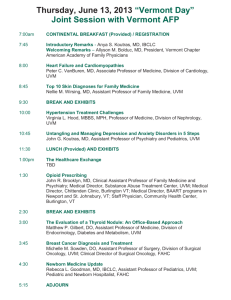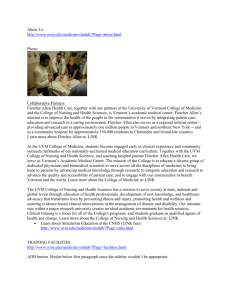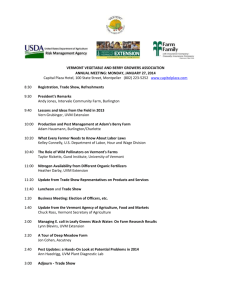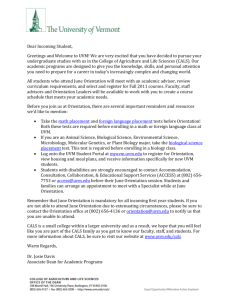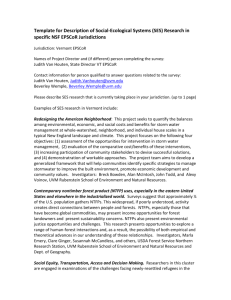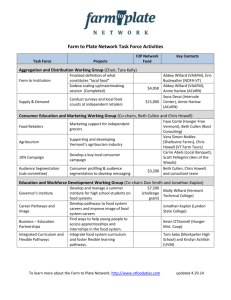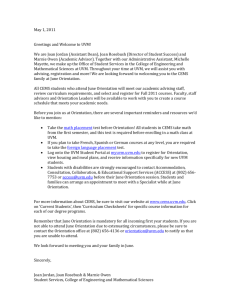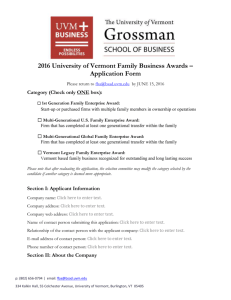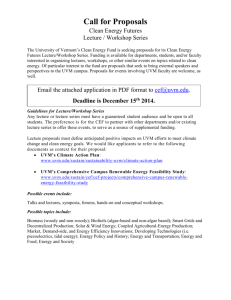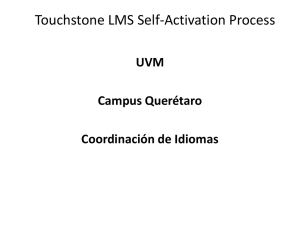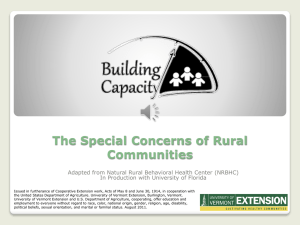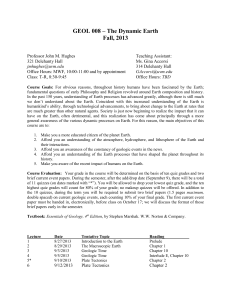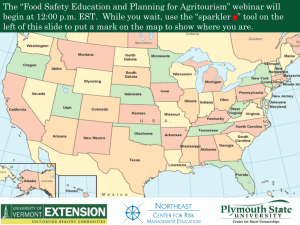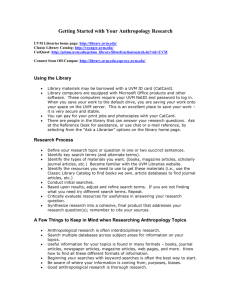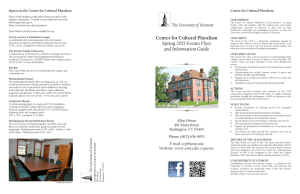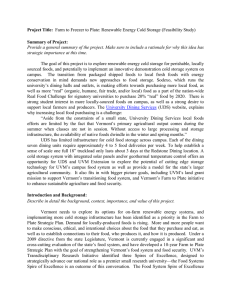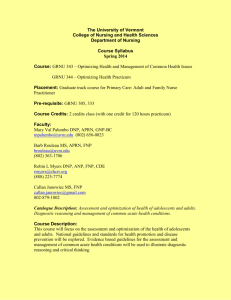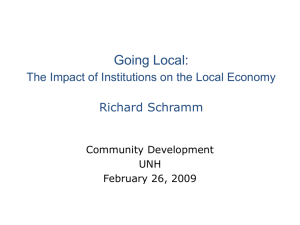GMP fact sheet_Aug 2012_final
advertisement
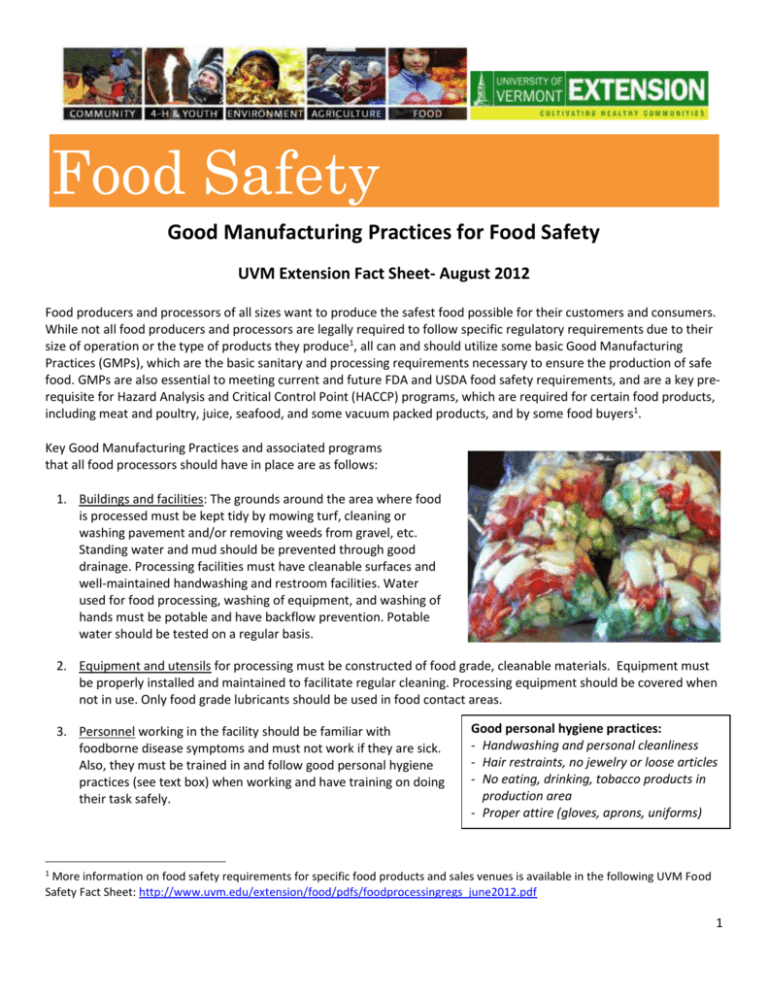
Food Safety Good Manufacturing Practices for Food Safety UVM Extension Fact Sheet- August 2012 Food producers and processors of all sizes want to produce the safest food possible for their customers and consumers. While not all food producers and processors are legally required to follow specific regulatory requirements due to their size of operation or the type of products they produce1, all can and should utilize some basic Good Manufacturing Practices (GMPs), which are the basic sanitary and processing requirements necessary to ensure the production of safe food. GMPs are also essential to meeting current and future FDA and USDA food safety requirements, and are a key prerequisite for Hazard Analysis and Critical Control Point (HACCP) programs, which are required for certain food products, including meat and poultry, juice, seafood, and some vacuum packed products, and by some food buyers1. Key Good Manufacturing Practices and associated programs that all food processors should have in place are as follows: 1. Buildings and facilities: The grounds around the area where food is processed must be kept tidy by mowing turf, cleaning or washing pavement and/or removing weeds from gravel, etc. Standing water and mud should be prevented through good drainage. Processing facilities must have cleanable surfaces and well-maintained handwashing and restroom facilities. Water used for food processing, washing of equipment, and washing of hands must be potable and have backflow prevention. Potable water should be tested on a regular basis. 2. Equipment and utensils for processing must be constructed of food grade, cleanable materials. Equipment must be properly installed and maintained to facilitate regular cleaning. Processing equipment should be covered when not in use. Only food grade lubricants should be used in food contact areas. 3. Personnel working in the facility should be familiar with foodborne disease symptoms and must not work if they are sick. Also, they must be trained in and follow good personal hygiene practices (see text box) when working and have training on doing their task safely. Good personal hygiene practices: - Handwashing and personal cleanliness - Hair restraints, no jewelry or loose articles - No eating, drinking, tobacco products in production area - Proper attire (gloves, aprons, uniforms) 1 More information on food safety requirements for specific food products and sales venues is available in the following UVM Food Safety Fact Sheet: http://www.uvm.edu/extension/food/pdfs/foodprocessingregs_june2012.pdf 1 4. Raw material control: Systems must be in place to check incoming raw materials for safety. Communication with suppliers should assure that they have effective food safety programs in place. Ingredients and packaging must be handled and stored safely (at proper temperature, in clean conditions, etc.) and used in a timely fashion (date all incoming products, use oldest products first). 5. Packaging materials: Food grade packaging, appropriate for its intended use, must be utilized and properly stored to prevent contamination. 6. Cleaning and sanitation: Standard Sanitation Operating Procedures (SSOPs) should be developed, documented, and utilized on a regular schedule for cleaning and sanitizing all food processing equipment. A sanitation schedule for areas that need periodic cleaning, such as coolers and storage facilities, should also be maintained. 7. Allergen control programs in place for the 8 major allergens2. Raw materials and final products containing allergens must be properly labeled, stored, and moved within the facility to prevent cross-contamination of products with allergens. Sanitation procedures must be in place to ensure complete removal of allergens from processing equipment (when switching processing lines from allergen to non-allergen containing products). 8. Pest control programs must control the presence of rodents, birds, insects and other pests in the following order: a) prevent entry into facilities, b) deny them food and water sources, c) exterminate as necessary. 9. Chemical control: Cleaners, sanitizers, lubricants and any non-food chemicals used in the facility must be kept separate from food ingredients and products. They must be properly labeled, stored, and used according to label instructions. Food and food packaging must be removed or covered before cleaning or using chemicals. 10. Glass control: Glass and glass-like foreign material in a facility must be controlled. This includes covering glass light bulbs and monitoring glass packaging and any other glass in the facility to prevent or at least detect breakage. 11. Foreign material control to prevent plastics, metal, wood and similar materials from getting into the food product. These are best controlled by a) careful visual inspection of raw materials during receiving and in-process, as well as and the final product; b) good personal hygiene of workers; and c) practicing good housekeeping. 12. Traceability and recall systems so the processor knows where their ingredients came from, which ingredients went into every batch of product, and where their products are going. This tracking is necessary in case a product must be recalled. A system for coding each “lot” of product should be in place. A “lot” may be one day of production, or one “batch” of product made in a day. For more information: FDA Good Manufacturing Practices (GMP) website: www.fda.gov/food/guidancecomplianceregulatoryinformation/currentgoodmanufacturingpracticescgmps/default.htm Fact sheet prepared by Dr. Londa Nwadike, UVM Extension Food Safety Specialist, londa.nwadike@uvm.edu; tel: 802-223-2389; 617 Comstock Road, Berlin, VT 05602 Fact sheet reviewed by: Vern Grubinger, UVM Extension Vegetable and Berry Specialist Elisabeth Wirsing, Food and Lodging Program Chief, Vermont Department of Health Al Burns, Sanitarian Supervisor, Vermont Department of Health UVM Extension helps individuals and communities put research-based knowledge to work. Issued in furtherance of Cooperative Extension work, Acts of May 8 and June 30, 1914, in cooperation with the United States Department of Agriculture. University of Vermont Extension, Burlington, Vermont. University of Vermont Extension, and U.S. Department of Agriculture, cooperating, offer education and employment to everyone without regard to race, color, national origin, gender, religion, age, disability, political beliefs, sexual orientation, and marital or familial status. 2 The 8 major allergens include: peanuts, tree nuts, milk, wheat, soy, fish, crustacean shellfish, eggs 2
